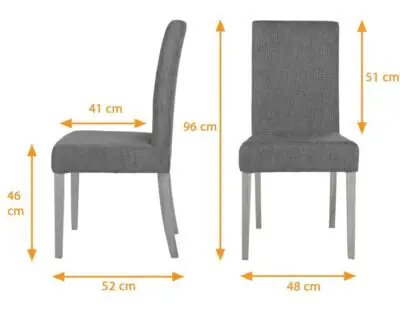Standard dining chair dimensions play an important role in ensuring comfort and functionality for anyone sitting at a dining table. When selecting dining chairs, it’s important to consider their dimensions to ensure they fit properly with the table and provide enough space for comfortable seating.
Typical dining chair dimensions include seat height, seat width, seat depth, and overall height. These measurements can vary slightly depending on the style and design of the chair, as well as the height and size of the dining table.
Understanding standard dining chair dimensions can help you choose the right chairs for your dining room and create a comfortable and inviting space for family and guests to enjoy meals together.
Understanding the Importance of Proper Chair Dimensions

Proper chair dimensions are crucial for ensuring comfort and preventing discomfort or pain while sitting. When chairs are too small or too large, they can cause poor posture, pressure points, and other issues that can lead to discomfort, pain, or even injury over time.
In the case of dining chairs, the right dimensions can make all the difference in creating a comfortable and functional dining experience. The seat height should be appropriate for the table height so that diners can sit with their feet flat on the ground and their knees at a 90-degree angle.
The seat width and depth should also be adequate to allow for comfortable sitting, and the overall height should be appropriate for the height of the table and the ceiling height of the room.
Proper chair dimensions are also important for people with disabilities or mobility issues. Chairs that are too low or too high can make it difficult for individuals to sit or stand up, while chairs that are too narrow or deep can be uncomfortable or unstable.
Overall, understanding the importance of proper chair dimensions can help you select chairs that provide comfort, support, and functionality for everyone using them. When choosing chairs, it’s important to consider factors such as height, weight, and mobility needs, as well as the intended use and design of the space they will be used in.
Recommended Seat Height for Dining Chairs
The recommended seat height for dining chairs is typically between 16 to 18 inches (40 to 46 cm) from the floor to the top of the seat. This height allows for comfortable seating at most standard dining tables, which are usually around 29 to 30 inches (74 to 76 cm) high.
However, it’s important to note that seat height can vary depending on the height of the table and the preferences of the individuals using the chairs. For example, if the dining table is higher than average, taller chairs may be needed to provide adequate legroom and a comfortable seating position.
Conversely, if the table is lower than average, shorter chairs may be more appropriate to maintain a comfortable height for the arms and hands while eating.
Additionally, people with mobility issues or disabilities may require chairs with a lower or higher seat height to accommodate their needs. It’s important to consider the individual needs of all users when selecting dining chairs to ensure comfort and functionality.
Ultimately, the recommended seat height for dining chairs should be based on the height of the dining table, the size and preferences of the individuals using the chairs, and any specific mobility or disability needs.
Determining the Ideal Seat Depth for Dining Chairs
Determining the ideal seat depth for dining chairs depends on various factors, including the size and height of the user, the intended use of the chair, and personal preferences for comfort.
The ideal seat depth for most adults is around 16 to 18 inches (40 to 46 cm). This allows for comfortable seating and proper support for the lower back. However, if the user is shorter or taller than average, the seat depth may need to be adjusted accordingly.
In addition to height, the intended use of the chair should also be considered when determining the ideal seat depth. For example, dining chairs that will be used for long periods of sitting, such as during dinner parties or family gatherings, may require a deeper seat to ensure comfort over extended periods of time.
Personal preferences for comfort also play a role in determining the ideal seat depth for dining chairs. Some people prefer a deeper seat to allow for more legroom, while others may prefer a shallower seat for a more upright posture.
Ultimately, the ideal seat depth for dining chairs should provide adequate support for the lower back while allowing for comfortable seating and meeting the individual needs and preferences of the user. It’s important to consider all of these factors when selecting dining chairs to ensure optimal comfort and functionality.
Choosing the Right Seat Width for Dining Chairs
Choosing the right seat width for dining chairs is important for ensuring comfort and functionality for anyone sitting at the dining table. The ideal seat width for dining chairs depends on the size and shape of the user, the size of the dining table, and personal preferences for comfort.
The recommended seat width for most adults is around 16 to 20 inches (41 to 51 cm). This provides enough space for comfortable seating and allows for a comfortable distance between diners. However, if the user is larger or smaller than average, the seat width may need to be adjusted accordingly.
In addition to the size of the user, the size of the dining table should also be considered when choosing the seat width for dining chairs. The chairs should fit comfortably around the table without crowding or impeding movement.
Personal preferences for comfort also play a role in choosing the right seat width for dining chairs. Some people may prefer a wider seat for more space, while others may prefer a narrower seat for a more intimate dining experience.
Ultimately, the right seat width for dining chairs should provide enough space for comfortable seating while allowing for optimal functionality and meeting the individual needs and preferences of the users. It’s important to consider all of these factors when selecting dining chairs to ensure optimal comfort and functionality.
Backrest Height and Angle Considerations for Dining Chairs
Backrest height and angle are important considerations when selecting dining chairs to ensure optimal comfort and support for the back. The ideal backrest height and angle depend on the size and shape of the user, the intended use of the chair, and personal preferences for comfort.
The recommended backrest height for dining chairs is around 12 to 20 inches (30 to 51 cm), providing adequate support for the lower and upper back. The height should allow the user’s back to rest comfortably against the chair without straining the neck or shoulders.
The backrest angle is also an important consideration when selecting dining chairs. The ideal angle is around 95 to 105 degrees, allowing the user to sit comfortably upright while providing adequate support for the lower back.
A more reclined angle may be more appropriate for chairs used for relaxation, while a more upright angle may be more appropriate for chairs used for dining or work.
Personal preferences for comfort also play a role in selecting the right backrest height and angle for dining chairs. Some people may prefer a higher backrest for more support, while others may prefer a lower backrest for a more open feel.
Ultimately, the right backrest height and angle for dining chairs should provide adequate support for the back while allowing for comfortable seating and meeting the individual needs and preferences of the user. It’s important to consider all of these factors when selecting dining chairs to ensure optimal comfort and functionality.
Legroom Requirements for Dining Chairs

Legroom is an important consideration when selecting dining chairs to ensure optimal comfort and functionality for anyone sitting at the dining table. The ideal legroom requirements for dining chairs depend on the size and height of the user, as well as the height of the dining table.
The recommended distance between the seat of the chair and the bottom of the table is around 10 to 12 inches (25 to 30 cm). This provides enough space for comfortable seating and allows for easy movement in and out of the chair. However, if the user is taller or shorter than average, the distance may need to be adjusted accordingly.
In addition to the distance between the seat and the table, the height of the chair is also important for legroom requirements. The ideal seat height for dining chairs is around 18 inches (46 cm), which allows for comfortable seating and proper support for the lower back. However, if the user is taller or shorter than average, the seat height may need to be adjusted accordingly.
Clearances and Spacing Around Dining Tables
Clearances and spacing around dining tables refer to the amount of space required to comfortably seat and accommodate diners around a table. This includes both the space between the table and the walls or other furniture in the room, as well as the distance between each chair or place setting.
The minimum clearance required around a dining table is typically 36 inches (91 cm) from the table edge to any walls or other furniture. This allows enough space for diners to move around and pull out their chairs without bumping into anything.
In terms of spacing between place settings, each diner should have at least 24 inches (61 cm) of space at the table. This includes both the space between chairs and the space between place settings on the table itself. This allows diners to comfortably move their arms and sit with proper posture while eating.
However, it’s important to note that the amount of space needed may vary depending on the size of the table and the number of people dining. Larger tables may require more clearance and spacing, while smaller tables may require less. It’s always a good idea to measure the space and consider the number of diners before purchasing a dining table or arranging a dining area.
Different Styles of Dining Chairs and Their Dimensions
There are several styles of dining chairs, each with its own distinct design and dimensions. Here are some of the most popular styles and their dimensions:
- Traditional dining chairs:
These chairs have a classic design, often featuring ornate details and rich upholstery. Traditional dining chairs typically measure around 18 to 20 inches wide, 18 to 20 inches deep, and 36 to 42 inches tall.
- Modern dining chairs:
These chairs have a sleek and minimalist design, with clean lines and simple shapes. Modern dining chairs can vary in size but typically measure around 16 to 20 inches wide, 18 to 22 inches deep, and 32 to 36 inches tall.
- Transitional dining chairs:
These chairs blend traditional and modern elements to create a unique look. Transitional dining chairs can vary in size but typically measure around 18 to 22 inches wide, 18 to 22 inches deep, and 36 to 42 inches tall.
- Parsons dining chairs:
These chairs have a simple and elegant design, with a square back and no arms. Parsons dining chairs typically measure around 20 to 25 inches wide, 18 to 22 inches deep, and 36 to 42 inches tall.
- Wingback dining chairs:
These chairs have a high back with wings that extend down to the arms. Wingback dining chairs typically measure around 25 to 30 inches wide, 25 to 30 inches deep, and 40 to 44 inches tall.
- French country dining chairs:
These chairs have a rustic and charming design, often featuring distressed finishes and natural materials. French country dining chairs typically measure around 18 to 22 inches wide, 18 to 22 inches deep, and 36 to 42 inches tall.
- Windsor dining chairs:
These chairs have a classic and timeless design, with a spindle back and scooped seat. Windsor dining chairs typically measure around 17 to 20 inches wide, 16 to 18 inches deep, and 36 to 42 inches tall.
Materials and Construction Impacting Dining Chair Dimensions

The materials and construction methods used in creating a dining chair can have a significant impact on its dimensions.
For example, chairs made from solid wood tend to be larger and heavier than those made from lighter materials like plastic or metal. This is because wood is a denser material and requires more material to achieve the same level of strength as other materials.
Similarly, the construction method used can also impact a chair’s dimensions. Chairs with more complex construction, such as those with intricate joinery or multiple pieces that need to be assembled, may be larger and more cumbersome than chairs with simpler construction methods.
In addition, the style of the chair can also play a role in its dimensions. For instance, traditional dining chairs tend to be larger and more ornate than modern, minimalist chairs. This is because traditional chairs are often designed to be more decorative and have more intricate details, which can increase their overall size and weight.
Overall, when choosing a dining chair, it is important to consider the materials and construction methods used, as well as the style of the chair, to ensure that it fits well with your dining table and room decor, as well as providing the necessary comfort and support for the users.
Common Mistakes to Avoid When Choosing Dining Chair Dimensions
Choosing the right dimensions for a dining chair can be a tricky task, and there are a few common mistakes that people often make.
Here are some mistakes to avoid when selecting dining chair dimensions:
- Choosing chairs that are too tall or too short: When selecting dining chairs, it’s important to consider the height of the table. Chairs that are too tall or too short can be uncomfortable to sit in and can also look awkward at the table.
- Overlooking the seat depth: Seat depth is an important factor in determining the comfort of a dining chair. If the seat depth is too shallow, it can be uncomfortable for taller individuals, while a seat that is too deep can be uncomfortable for shorter individuals.
- Ignoring the width of the chair: The width of the chair is also an important consideration, as chairs that are too wide can be difficult to move around, while chairs that are too narrow can be uncomfortable for larger individuals.
- Forgetting to consider the armrests: If you are selecting chairs with armrests, it’s important to consider the height and width of the armrests. Armrests that are too high or too wide can make it difficult to push the chair in under the table.
- Overlooking the style of the chair: While it’s important to choose chairs that are comfortable and functional, it’s also important to consider the style of the chair and how it fits in with the overall decor of the room.
By avoiding these common mistakes and carefully considering the dimensions of your dining chairs, you can select chairs that are comfortable, functional, and aesthetically pleasing.
Conclusion
If you want to know the standard dining chair dimensions, then you need to read this post. Standard dining chair dimensions can vary depending on the design and construction of the chair, as well as the height of the dining table.
Generally, dining chairs have a seat height of 18-20 inches, a seat depth of 16-18 inches, and a seat width of 16-20 inches. However, it’s important to carefully consider the dimensions of the dining chairs you are selecting to ensure that they are comfortable, functional, and fit well with your dining table and room decor.
By avoiding common mistakes and taking the time to choose the right dimensions, you can ensure that your dining chairs are a comfortable and stylish addition to your dining room.


